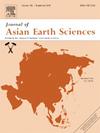风场、沉积物源和盆地构造在滩坝沉积体系形成中的作用——以渤海湾盆地沾化凹陷古近系沙河街组为例
IF 2.4
3区 地球科学
Q2 GEOSCIENCES, MULTIDISCIPLINARY
引用次数: 0
摘要
滩坝体系作为陆相湖盆的重要储层,其形成机制和控制因素的研究取得了显著进展。然而,在断陷过渡时期复杂的盆地背景下,不同滩坝类型的分布模式、控制机制和油气勘探潜力仍然缺乏明确的约束。以渤海湾盆地沾化凹陷古近系二段(沙二段)为研究对象,综合测井资料、岩心资料、三维地震解释等,系统分析了滩坝沉积特征、主控因素及勘探潜力。沙2区滩坝分为砂岩滩坝、碳酸盐岩滩坝和碎屑岩滩坝三种类型。纵向上,从第4部分到第1部分,沉积规模逐渐增大,横向上,其分布遵循风场、沉积物源和盆地构造三方耦合机制:东北向风场驱动波浪作用,形成西北-东南向的滩坝;沉积物供给强度决定了滩坝岩性(高供给区以砂岩为主,低供给区以碳酸盐岩为主);断陷过渡时期独特的盆地构造(陡坡-深水-缓坡)控制了空间分异。储层特征为高孔隙度(25% ~ 30%)、低渗透率(20 ~ 50 mD), 2 ~ 6 m厚砂坝为主要勘探目标。特别是南部缓坡区与泥岩盖层互层的叠合滩坝具有较好的油气成藏条件。这些发现阐明了构造过渡时期滩坝的成因机制及其油气富集模式,为类似盆地岩性油气藏勘探提供了重要的地质参考。本文章由计算机程序翻译,如有差异,请以英文原文为准。
The role of windfield, sedimentary sources, and basin structure in the formation of beach-bar deposition systems: A case study in Paleogene Shahejie formation in the Zhanhua Sag of the Bohai Bay Basin, China
Beach bar systems, as significant reservoirs in terrestrial lacustrine basins, have led to notable progress in understanding their formation mechanisms and controlling factors. However, under the complex basin setting during the fault-depression transition period, the distribution patterns, controlling mechanisms, and hydrocarbon exploration potential of different beach bar types remain poorly constrained. This study focuses on the Paleogene Second Member (Es2) in the Zhanhua Sag, Bohai Bay Basin, China, integrating well logs, core data, and 3D seismic interpretation to systematically analyze the sedimentary characteristics, dominant controls, and exploration potential of beach bar deposits. Three types are identified in the Es2: sandstone beach bars, carbonate-dominated beach bars, and clastic-dominated beach bars. Vertically, the scale of these deposits gradually increases from Part 4 to Part 1, while laterally, their distribution follows a tripartite coupling mechanism involving windfield, sedimentary sources, and basin structure: northeast-trending windfields drive wave action to form northwest-southeast-oriented beach bars; sediment supply intensity determines beach bar lithology (sandstone-dominated in high-supply zones vs. carbonate-dominated in low-supply zones); and the unique basin structure (steep slope–deep water–gentle slope) during the fault-depression transition controlled spatial differentiation. Reservoir characterization shows high porosity (25 %–30 %) but low permeability (20–50 mD), with 2–6 m thick sandy bars serving as prime exploration targets. In particular, stacked beach bars interbedded with mudstone seals in the southern gentle slope exhibit superior hydrocarbon accumulation conditions. These findings elucidate the genetic mechanisms of beach bars during a tectonic transition and their hydrocarbon enrichment patterns, providing critical geological references for lithologic reservoir exploration in analogous basins.
求助全文
通过发布文献求助,成功后即可免费获取论文全文。
去求助
来源期刊

Journal of Asian Earth Sciences
地学-地球科学综合
CiteScore
5.90
自引率
10.00%
发文量
324
审稿时长
71 days
期刊介绍:
Journal of Asian Earth Sciences has an open access mirror journal Journal of Asian Earth Sciences: X, sharing the same aims and scope, editorial team, submission system and rigorous peer review.
The Journal of Asian Earth Sciences is an international interdisciplinary journal devoted to all aspects of research related to the solid Earth Sciences of Asia. The Journal publishes high quality, peer-reviewed scientific papers on the regional geology, tectonics, geochemistry and geophysics of Asia. It will be devoted primarily to research papers but short communications relating to new developments of broad interest, reviews and book reviews will also be included. Papers must have international appeal and should present work of more than local significance.
The scope includes deep processes of the Asian continent and its adjacent oceans; seismology and earthquakes; orogeny, magmatism, metamorphism and volcanism; growth, deformation and destruction of the Asian crust; crust-mantle interaction; evolution of life (early life, biostratigraphy, biogeography and mass-extinction); fluids, fluxes and reservoirs of mineral and energy resources; surface processes (weathering, erosion, transport and deposition of sediments) and resulting geomorphology; and the response of the Earth to global climate change as viewed within the Asian continent and surrounding oceans.
 求助内容:
求助内容: 应助结果提醒方式:
应助结果提醒方式:


